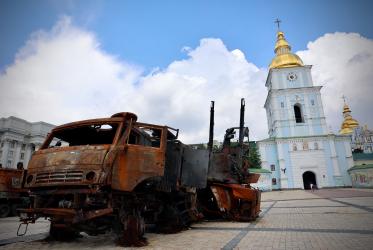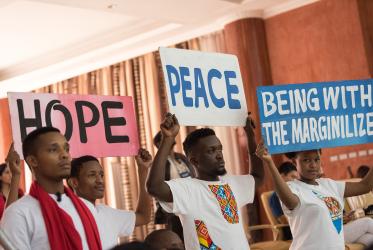By Susan Kim*
Anglican parishes in the United Dioceses of Dublin and Glendalough in the Republic of Ireland are seeking new paths and projects for 2016 after considering the results of a survey that identified successes and concerns among laity.
A report on the survey, entitled “Come&C,” shows the aspirations, achievements, and concerns of parish communities across Dublin and Glendalough, which are placed in Ireland’s diverse urban and rural communities of some one-and-a-half million people.
The parishioners decided to focus on the theme of “Witness, Worship and Welcome” during 2016, specifically looking through the lens of the Five Marks of Mission of the Anglican Communion: how do we witness (tell the good news), teach (baptise and nurture new believers), tend (respond to human need), transform (challenge unjust structures and violence and pursue peace and reconciliation) and treasure (safeguard the integrity of creation and sustain life on earth).
Parishioners began by celebrating what was already happening in their parishes or dioceses that they felt encouraged, enhanced and deepened their awareness of the Five Marks of Mission. Then they began developing new initiatives that will widen the marks of mission.
They designated 2016 as “the year of Come&C” as they continue to develop projects and activities with the same energy that Jesus had when He said to the disciples: “come and see.”
‘Truly a voice of the laity’
More than 79% of parishes responded to the survey on which the “Come&C” report is based, and “a significant proportion of them happened to be without a rector at the time,” wrote the Most Rev. Michael Jackson, archbishop of Dublin and Bishop of Glendalough, the Anglican Primate of Ireland, in the foreword of the report. “This is, therefore, truly a voice of the laity of the diocese and for that reason precious.”
Jackson wrote: “The pulsating question always is: Where do we go from here? or, What do we do next? It has been my privilege to listen to you speak in your own voice.”
When parishioners described what they were most proud of in their parishes, many of them acknowledged that their parishes were open and friendly to the community. They were also pleased to support training and education from Scripture, and considered themselves biblical functioning communities.
When asked about their hopes for the future, many expressed a desire for greater involvement of the Church of Ireland with children and youth, and a desire for services which would be attractive to younger people.
As they compiled “vision statements” together, the parishes expressed a wish to provide a Christian witness to the growing and diverse community, and to serve as a spiritual centre for the whole community.
Disciples every day
The “Come&C” initiative aims to equip people to be disciples in their everyday living whether it be by social action, community projects or through different forms of worship.
The project also aims to soften the barriers between parishes by facilitating gatherings that allow people from neighbouring parishes to get to know each other and to allow people from smaller parish communities to feel part of a larger diocesan family. Many parishioners said that the Come&C report helped people to look afresh at their own parishes.
Three things in particular emerge as priorities in the life of the parishes who have responded to the questionnaire, Jackson observed in the report. The first, he wrote, is that “these dioceses put forward the largest number of people for confirmation in the whole of the Church of Ireland.”
The second is that there is a hunger for lay discipleship. “The repeated discussion and the wide range of examples of community involvement inside and outside the parish marches hand-in-hand with the expressed need for imaginative equipping and innovative facilitation of discipleship,” he wrote.
The third, he wrote, “is a question begged more than a question answered. It is the engagement with the community at its widest. It is the recognition that those at the margins have a voice with the centre and that this relationship flourishes where there is attentive listening combined with loving action.”
Connecting with the ecumenical community
Already many of the parishes in these dioceses are connected with the wider community of faith in ways which are intrinsic to not only the Anglican communion but also the other faith traditions, said Jackson.
“The Five Marks of Mission which form the core of Come&C are not confined to the Anglican tradition,” he said. “They are, however, marks of its expression. Part of the excitement and of the invitation is to connect with them in the wider ecumenical, and indeed faith, communities to which we belong by shared citizenship and public life.”
Jackson urged people to grasp the joy of the intentionality of what they are doing within the walls of their parishes and beyond. “Come&C gives a structured sense of purposeful and intentional discipleship. It also offers opportunity to proclaim the faith that lies at the heart of each of the Marks of Mission,” he said. “People individually will be given the opportunity to explore one or more marks by engaging with the context and community around them by doing something relevant to the Mark of Mission in question; by relating this to the scriptures; and by writing a prayer coming out of the total experience. The next steps for parishes will be to Go&Tell and to invite others to discipleship by their deeds and their words, by their daily lives and by their public worship.”
Best practices, growing practices
Parishioners in the United Dioceses of Dublin and Glendalough acknowledged that their parishes house committed and gifted people in many areas of ministry along with a servant heart. In other words, parishes see their people as one of their greatest assets.
Parishes also cited ecumenical engagement in events such as the Week of Prayer for Christian Unity, coordinated jointly by the World Council of Churches Commission on Faith and Order and the Roman Catholic Church through its Pontifical Council for Promoting Christian Unity.
Parishes also reported that they celebrate major Christian festivals ecumenically, and many parishes celebrate harvest festivals that are open to villages within the wider community.
A very strong feeling among the parishioners is that empowering young people and lay adults will ensure proper team ministry and support for the rector. In the Come&C report, Jackson wrote that, “this new relationship will enable the energy that there so clearly is in any small community to take its place in the significant contribution it will make to the wider community, both within and beyond the Christian tradition. All of these people are also our neighbours. This is an exciting challenge for us all.”
*Susan Kim is a freelance writer from Laurel, Maryland, United States.







